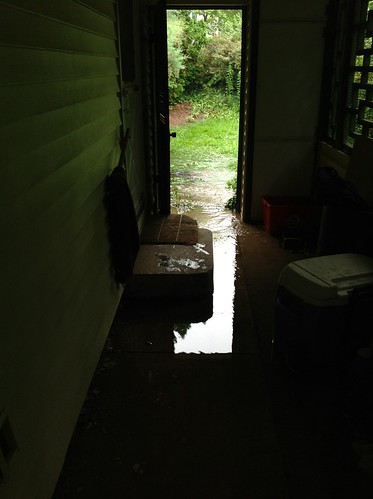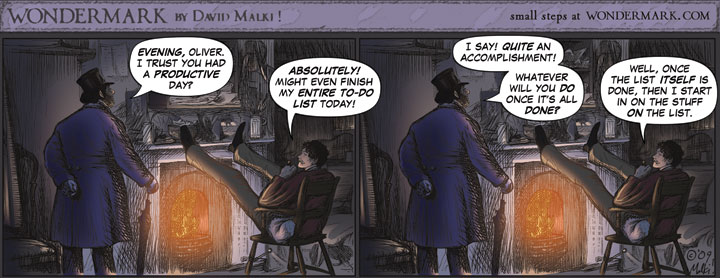Highly useful things, brain dumps. If done in an organized fashion, of course. I started writing about the why of organization, but the post got far too long. So that will be tomorrow.
Today is going to be about the how instead.
One of my very favorite tools for organizing my thoughts is an Open Source mindmapping program called Freemind. It’s free, and runs on Windows, Mac, and Linux (a crucial bit for me).
Mindmapping is a way of recording ideas hierarchically and visually, like this.
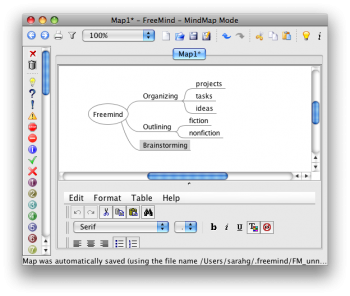
There are a lot of options available, but for getting ideas down as fast as possible I find the keyboard shortcuts to be the most useful. Each bit of the diagram is called a node. Insert (Tab on the Mac) adds a new child node (one step down the hierarchy from the selected node). Enter adds a new node at the same level (with the same parent). The arrow keys work in the expected way. And of course, you can use the mouse to select and add nodes too.
Clicking on a node that has children closes it. You don’t have to look at everything all the time.
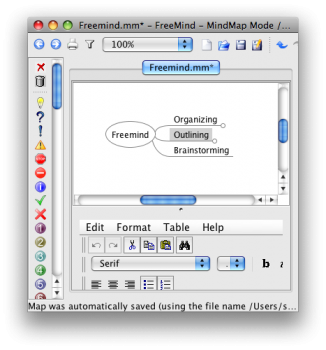
A lot of times that’s all you need. Putting your ideas down, well, gets them down. From there you can work with them.
For brainstorming and outlining small projects, this quick note-taking is entirely sufficient. But for longer projects, where you might want to refer to a particular mindmap for months or years, there are lots of options. You can color things, surround them in clouds, and add icons.
People seem to think that I get a lot of things done even though I always feel behind. Organization is a key part of my productivity. I use Freemind for a lot of task and project management. This is my to-do list (and yes, I know you can’t read it).
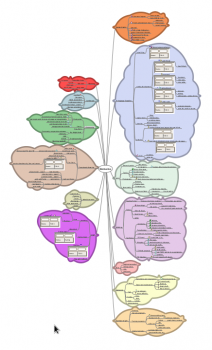
Each project area has its own colored cloud, and I’ve added icons to specific tasks: the 1, 2, 3 and so on to denote importance. I have things that need to be done now, and things to be done when I get around to it.
The icons are useful as more than visual reminders. I can filter the mindmap on any of them, so the map only shows top-priority tasks, or whatever else I’ve organized them by.
For outlining a big writing project, icons could mark areas that need research, items that are done, and items that need work. Or whatever suits your organizational system and that particular project.
Freemind recently added the ability to use text attributes: classes and tags. But so far this feature seems clunky and hard to use. It has a lot of potential, but isn’t something I use regularly. The gray boxes on the to-do list are attributes. I tried it again on this map to see if the implementation was more to my taste yet, but it isn’t. They’re slow to add; icons are much easier, and accomplish something similar when used with filtering.
Most of the project areas have one or more separate mindmaps too, with links in this master map so I can click on the link and open the project-specific map. That keeps everything indexed in one place, but keeps the index from getting too large and cluttered.
My main considerations for software like this, and I’ve tried a lot of the available software packages: ease of getting ideas down in the first place; options for tagging and filtering; cross-platform use. That last one is very important for me, though I realize it isn’t a dealbreaker for many people. I keep my main mindmaps in my Dropbox* folder so I can access them from anywhere. In my case, “anywhere” includes Mac, Linux, and occasional Windows use. Freemind runs on all three, so I’m set.
I use Freemind for task management, brainstorming, writing literature reviews, organizing projects, plotting fiction… it’s one of my most useful pieces of software. And it’s free, so give it a try.
* Dropbox really deserves a separate post. Briefly, it’s a backup folder that is synchronized between all my computers. I keep current projects and reference materials there. Those files are always backed up, and always accessible no matter where I am or what computer I’m using. If you’d like to try it, it’s free. You can sign up yourself, but if you ask me for an invite we both get extra space.

